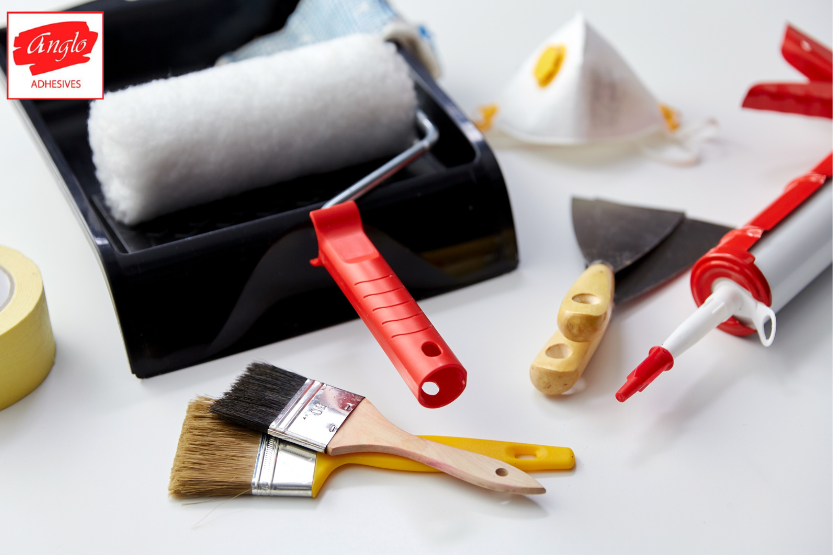Blog
When to Bond, When to Block: The Difference Between Sealant and Adhesive

Ever grabbed the wrong tube on the job, only to realise later it wasn’t quite the right fit? Sealants and adhesives, those titans of the toolbox, often get confused. But for UK contractors, understanding the key distinctions between these two can mean the difference between a watertight seal and a frustrating do-over. In this blog, we’ll break down the nitty-gritty of sealants versus adhesives, helping you choose the right tool for the job, every time.
Understanding Sealants: Creating Barriers, Not Bonds
Sealants are primarily known for their ability to fill gaps and create watertight, airtight, or dust proof barriers. They are often paste-like in consistency and remain flexible after curing. Additionally, common applications for sealants include:
- Filling gaps around windows and doors to prevent drafts and leaks.
- Sealing cracks in countertops, bathtubs, and showers to prevent water damage.
- Sealing joints between dissimilar materials, like concrete and wood, to prevent movement and cracking.
Sealants excel at:
- Accommodating movement: Due to their flexibility, sealants can adapt to slight movements between materials, hence, maintaining the integrity of the seal.
- Weather resistance: Many sealants are formulated to withstand harsh weather conditions, thus, making them ideal for exterior applications.
- Adhesion to various materials: Sealants can adhere well to a wide range of surfaces, including concrete, brick, wood, and metal.
However, sealants have limitations:
- Limited bonding strength: While they can create a good secondary bond, sealants are not designed for high-stress applications that require strong structural reinforcement.
Understanding Adhesives: The Power of Bonding
Adhesives, on the other hand, are formulated to create a strong, permanent bond between two surfaces. Moreover, they come in various forms, from liquids to tapes, and typically harden after application. Here are some common uses for adhesives:
- Bonding wood for furniture construction or repairs.
- Attaching flooring materials like vinyl or laminate.
- Securing tiles to walls or countertops.
- Repairing broken household items made of ceramic, plastic, or wood.
Adhesives excel at:
- High bonding strength: They can withstand significant loads and stresses, thus, making them ideal for structural applications.
- Fast curing times: Many adhesives offer rapid curing times, as a result, allowing for efficient project completion.
- Creating a rigid bond: The cured adhesive creates a firm connection between materials, hence, ensuring long-term stability.
However, adhesives also have limitations:
- Limited flexibility: Unlike sealants, adhesives are generally not flexible and may crack or fail if subjected to excessive movement.
- Surface limitations: Some adhesives bond best with specific materials. Additionally, it’s crucial to choose the right adhesive for the surfaces you’re working with.
Choosing the Right Tool by Understanding the Difference Between Sealant and Adhesive
Now that you understand the difference between sealant and adhesive, how do you decide which one to use? Here’s a simple guideline:
- Need to create a barrier or fill gaps? Choose a sealant.
- Need to permanently bond two surfaces together? Choose an adhesive.
Remember: Overlap sometimes exists. For instance, some high-performance sealants offer some bonding strength, while certain flexible adhesives can accommodate slight movement. Before you get started, make sure to check the product information for specific instructions. If you’re not sure about something, don’t hesitate to ask a qualified professional for help.
Difference Between Sealant and Adhesive: Substrates and Special Considerations
An important factor to consider when choosing between these products is the type of surface, or substrate, you’ll be working with. Some sealants are specifically formulated for adhering to particular materials, like silicone sealants for bathrooms or acrylic sealants for concrete. Similarly, adhesives come in varieties optimised for bonding wood, metal, plastic, or even fabrics.
Here are some additional considerations to keep in mind:
- Environmental factors: Will your project be exposed to extreme temperatures, moisture, or UV rays? Choose a sealant or adhesive formulated to withstand the specific environment.
- Cure time: Some sealants and adhesives offer rapid curing times, making them ideal for quick projects. Others take longer to cure, requiring patience during application.
- Desired aesthetics: Sealants often come in a variety of colours for a more finished look, while adhesives are typically clear or inconspicuous.
By understanding the difference between sealant and adhesive, along with these additional factors, you’ll be well-equipped to choose the right product for any project. The following sections will explore specific applications for sealants and adhesives, along with some helpful tips for successful construction or repair projects.
Empowering Your Construction Journey with Anglo Adhesives
Understanding the difference between sealant and adhesive empowers you to tackle your next project with confidence. By choosing the right tool for the job, you can ensure long-lasting, successful results. For expert advice on selecting the perfect adhesive or sealant for your specific needs, don’t hesitate to contact Anglo Adhesives. We’re dedicated to helping you find the right solution for any bonding or sealing challenge.